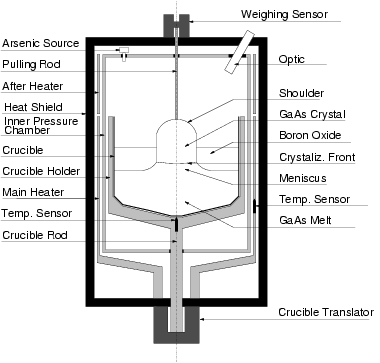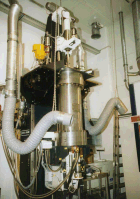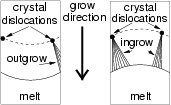Basics of the Process
In this section some well known facts about Czochralski crystal growth
are presented. They seem to be required for a basic understanding of the
difficulties encountered in diameter control.
Introduction
The main idea of the Czochralski-process was developed in the year 1918
by the Polish scientist Jan
Czochralski (1885-1953). Henceforth, this process is called the standard
process. Over the years, it has often been modified in order to embrace higher requirements.
Two important variants of the standard process are the liquid encapsulated
(LEC) and the vapour pressure controlled (VCz) process.
 The figure in the right shows a sketch of the Cambridge Instruments
CI358 puller used at the Institute
of Crystal Growth. The inner chamber and its
peripheral devices were completely modified by the Institute
of Crystal Growth such as to ensure growth of large diameter high quality
crystals using the VCz-technique.
The figure in the right shows a sketch of the Cambridge Instruments
CI358 puller used at the Institute
of Crystal Growth. The inner chamber and its
peripheral devices were completely modified by the Institute
of Crystal Growth such as to ensure growth of large diameter high quality
crystals using the VCz-technique.
A crucible consisting of boron-nitride contains the molten
gallium-arsenide (GaAs). A pulling rod holds the crystal which is
pulled up carefully while rotating. To make dislocations grow out
of the crystal the radius increases slowly in the area of the shoulder.
Because of the surface tension the crystallization front, which
is the phase interface between solid and liquid GaAs, resides a bit above
the melt level. The liquid GaAs does not wet the crystal completely. In
fact it contacts the solid crystal under a certain angle  ,
the so called contact-, wetting-, or meniscus-equilibrium angle. ,
the so called contact-, wetting-, or meniscus-equilibrium angle.
The area of the melt below the crystal which is raised above the melt
level is called meniscus. The crystallization front has the temperature
of the melting point of GaAs (1511 Kelvin). The position of the crystallization
front raised above the melt is very important for the properties of the
growth process. If it is raised to far above the melt the crystal radius
decreases, otherwise it increases. Furthermore, the shape of the front should
be slightly convex (seen from the melt) to ensure dislocations growing
out.
Correct positioning of the crystallization front
The main problem in diameter control is the unstable character of the crystallization front
position which leads to a cylindrical crystal. If the
diameter decreases, then the amount of heat which flows through the crystal decreases,
too. As a result, the temperature in the area around the crystallization
front increases; this forces the decrease of the crystal-diameter, and
so on. Conversely, an increasing diameter leads to a greater heat loss
through the crystal, the temperature decreases, and because of this the
diameter increases. On the other side: An increasing diameter results in
an increasing interface surface and as a consequence the amount
of latent heat goes up. So, the latter effect slightly stabilizes
the region!
Heat convection in the melt can be influenced by rotating both the crystal and the crucible about their common vertical axis. Furthermore, the crucible can be raised within the main heater's temperature field such as to achieve optimal heat input into the system.
Both liquid and solid GaAs have a very high arsenic vapour pressure.
Therefore, GaAs tends to dissociation. To prevent evaporation of arsenic
from the melt it can be encapsulated under a layer of liquid boron-oxide.
Simultaneously, the process takes place under heightened pressure which
results in the need of a pressure chamber. A standard-Czochralski
process modified in such a way is called liquid encapsulated
Czochralski (LEC). By this invention it became possible to grow GaAs
or in general III-V-semiconductors with satisfying results using the Czochralski technique.
Importance of the temperature field
 In order to produce crystals with minimum dislocation densities it is necessary
to have a nearly linear temperature field within the crystal. This means that partial derivatives of the temperature greater than first order are equal to zero. This condition can be approximately achieved by minimizing
the radial and axial temperature gradients. Particularly, the radial temperature
gradient has to be reduced to ensure an axial heat flow through the crystal which is
as linear as possible. Using the conventional LEC-process it is not possible
to achieve this aim when growing large diameter crystals. The temperature
profile within the crystal is very disadvantageous in this case, so the
amount of dislocations increases in a untenable way.
In order to produce crystals with minimum dislocation densities it is necessary
to have a nearly linear temperature field within the crystal. This means that partial derivatives of the temperature greater than first order are equal to zero. This condition can be approximately achieved by minimizing
the radial and axial temperature gradients. Particularly, the radial temperature
gradient has to be reduced to ensure an axial heat flow through the crystal which is
as linear as possible. Using the conventional LEC-process it is not possible
to achieve this aim when growing large diameter crystals. The temperature
profile within the crystal is very disadvantageous in this case, so the
amount of dislocations increases in a untenable way.
A minimization of the temperature gradients can be achieved by using
new insulation materials for the heat-shield. Moreover, an additional gas
proof chamber is used the temperature of which is about 1000 Kelvin. However, these
steps, which indeed result in lower temperature gradients, diminish the
compositional stability of the crystal: Arsenic begins to sublimate from
the crystal, which starts to degenerate. To avoid this terrible effect
an arsenic-source is used to inject arsenic into the atmosphere.
Therefore, the crystal grows in thermodynamical equilibrium - it gets a
mirroring surface. This modified LEC process is called the vapour pressure
controlled Czochralski (VCz). It provides a key for growing large diameter
GaAs-crystals with low dislocation densities using the Czochralski technique.
It has to be remarked that it is -of course- possible to grow large diameter
crystals with conventional LEC methods (or different process concepts),
but the great amount of dislocations within such crystals forbids this type of processing
for opto-electronic or epitaxial components.
|


 The figure in the right shows a sketch of the Cambridge Instruments
CI358 puller used at the
The figure in the right shows a sketch of the Cambridge Instruments
CI358 puller used at the 

 In order to produce crystals with minimum dislocation densities it is necessary
to have a nearly linear temperature field within the crystal. This means that partial derivatives of the temperature greater than first order are equal to zero. This condition can be approximately achieved by minimizing
the radial and axial temperature gradients. Particularly, the radial temperature
gradient has to be reduced to ensure an axial heat flow through the crystal which is
as linear as possible. Using the conventional LEC-process it is not possible
to achieve this aim when growing large diameter crystals. The temperature
profile within the crystal is very disadvantageous in this case, so the
amount of dislocations increases in a untenable way.
In order to produce crystals with minimum dislocation densities it is necessary
to have a nearly linear temperature field within the crystal. This means that partial derivatives of the temperature greater than first order are equal to zero. This condition can be approximately achieved by minimizing
the radial and axial temperature gradients. Particularly, the radial temperature
gradient has to be reduced to ensure an axial heat flow through the crystal which is
as linear as possible. Using the conventional LEC-process it is not possible
to achieve this aim when growing large diameter crystals. The temperature
profile within the crystal is very disadvantageous in this case, so the
amount of dislocations increases in a untenable way.